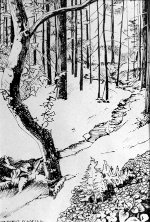Best known for: The Great Wave of Kanagawa, 36 Views of Mount Fuji
When I was little I thought I knew a secret: that Japanese art from the Edo period is wonderful. Hokusai’s 36 Views of Mount Fuji is a very well known series, and The Great Wave off Kanagawa is the most recognizable and reproduced piece. I first encountered this piece as a young girl inside a Japanese restaurant. It was printed across two pieces of cloth that were hanging over a doorway. It was love at first sight.
Over the years Hokusai has remained my favorite. Once while cutting through the Art Institute of Chicago (a common student practice for SAIC students looking for a break from the cold), I looked over and stopped dead in my tracks. There were the 36 Views of Mount Fuji just twenty feet away! I later stood in that exact spot and looked at where they hung and I am not sure how I even saw them from that angle. At that moment they jumped out and grabbed me. I hurried over through the intricate maze of museum walls in the Asian wing and arrived before them. They were so small. I couldn’t believe it (they’re approximately 10” x 15”). I stood there for an hour. I returned over and over, always finding new moments with these pieces. When I said goodbye before the show closed it was with tears in my eyes. Luckily, these wonderful artworks are prints so there are many copies and many chances to see them.
There was a different perspective in traditional Japanese art. The art shows a view of looking in rather than across. The styles show the importance of a story rather than the western trumpe-l’oeil effect of trying to make something “real”. Art from the west arrived in Japan in the late 1500s and slowly started to influence Japanese artists. Later the merchant class wanted to have western style art and since the country had since closed to outsiders the ukiyo-e artist was able to make them. The Edo period (1615-1868) was a very interesting time in Japanese art as these prints were readily available and could explore western ideas such as horizontal plane, two-point perspective and shading.
The Great Wave has all these influences present. The print was wildly popular in its time and remains so today. Prints from Japan traveled far and wide influencing many artists. Japonism is a term that refers to the Japanese influence on western art, especially Impression. This style of art mirrors the Japanese style of a lack of perspective (or a rather a different type of perspective), lack of shadows, flat blocks of color (woodblock printing) and a different type of composition, often seen with a low placed diagonal. Van Gogh’s Branches with Almond Blossom is a good example of this influence. The very simple background, outlining of the tree, and low diagonal of the larger branch can all be traced back to Japanese prints.
 I am influenced by this idea of looking into the landscape rather than across it. Here is a simple ink sketch I did that is very reminiscent of Japanese landscapes and for that reason is one of my favorite site sketches.
I am influenced by this idea of looking into the landscape rather than across it. Here is a simple ink sketch I did that is very reminiscent of Japanese landscapes and for that reason is one of my favorite site sketches.
I went to the beach last weekend. The sand slopes steeply into the water. The waves were crashing and reaching up on the sand the best they could. The water was very foamy and I saw, for the first time, moments where the water had the same fingers at the edges similar to “the Great Wave. It was wonderful to feel like my daily life suddenly had a personal tie to such a great piece of artwork, almost two hundred years later.


